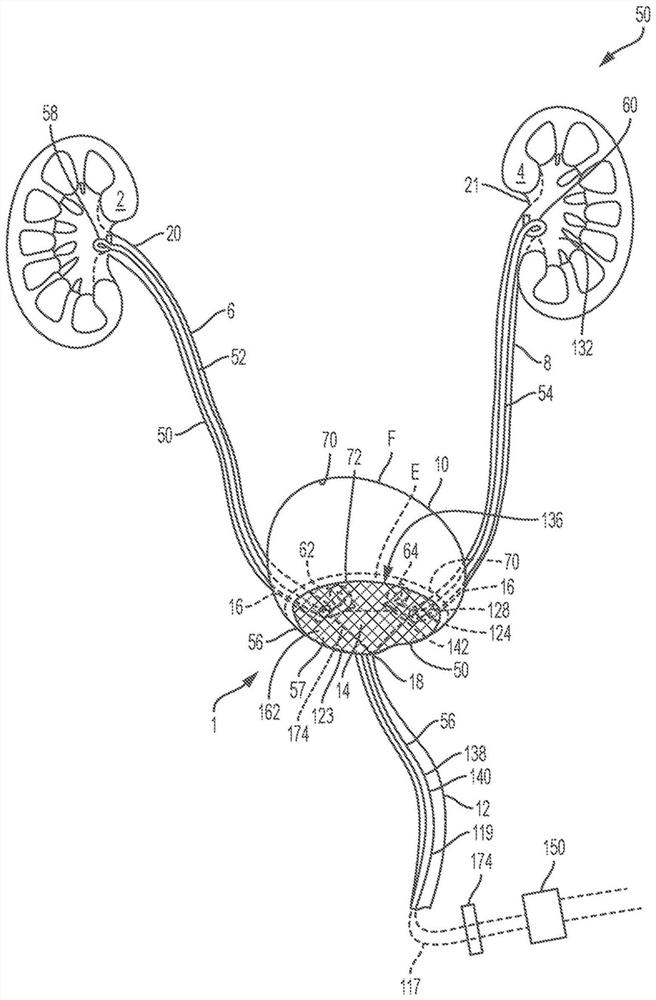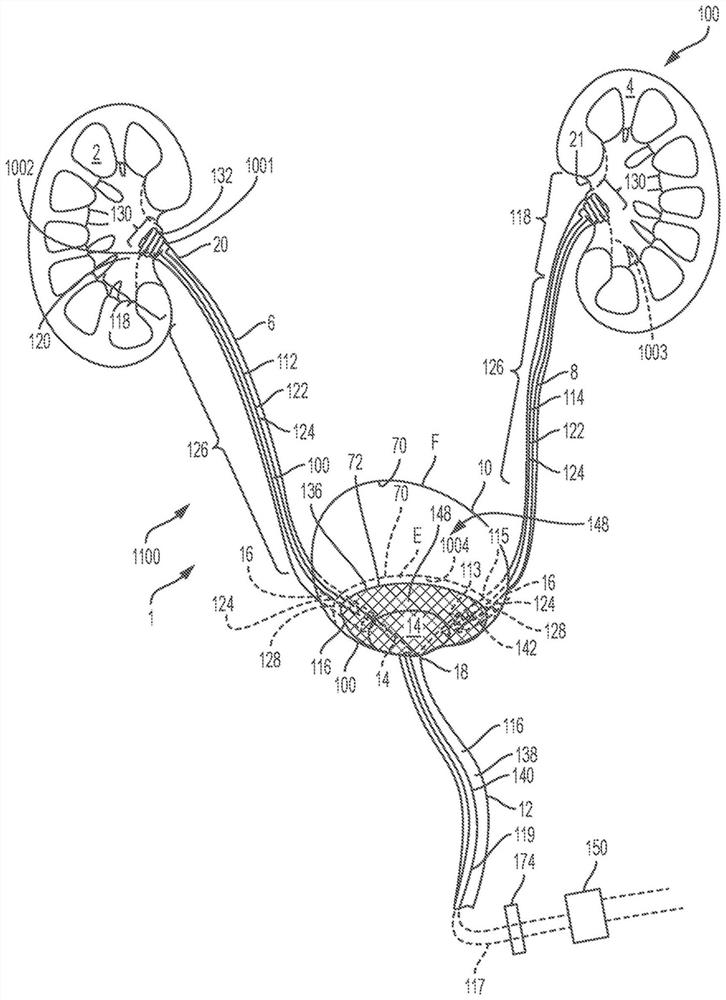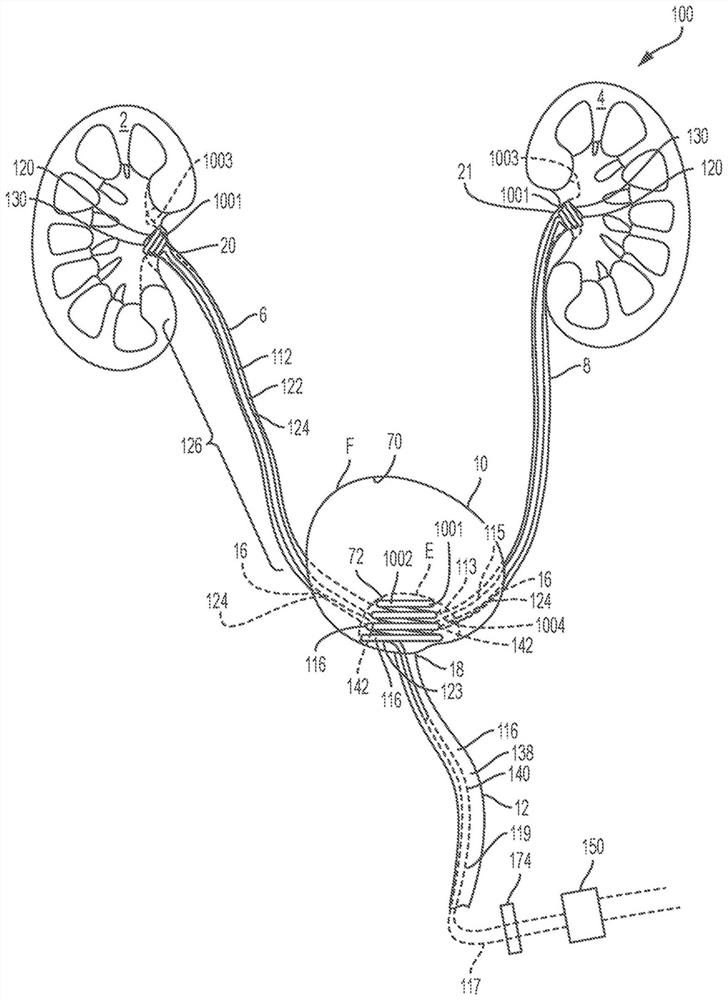Coated and/or impregnated ureteral catheter or stent and manufacturing method thereof
A technology for coating and urinary catheters, which is applied in the direction of catheters, coatings, and pharmaceutical formulations, and can solve the problems of failing to improve the renal function of patients with cardiorenal syndrome
- Summary
- Abstract
- Description
- Claims
- Application Information
AI Technical Summary
Problems solved by technology
Method used
Image
Examples
Embodiment 1
[0334] Example 1 shows positioning tubes with openings of different sizes (which correspond to Figure 11 The liquid flow distribution of the embodiment of positioner 1330 shown in . As shown in Table 3, the closest opening (Q 6 ) is 0.48mm in diameter, and the farthest opening on the side wall of the tube (Q 5 ) has a diameter of 0.88mm, while the open distal end of the tube (Q 6 ) has a diameter of 0.97mm. Each opening is circular.
[0335] The flow distribution percentage and calculated volumetric flow are determined as follows.
[0336] Path to station B via the far end of the pipe (path 1)
[0337]
[0338] Route to Station B via side wall opening (Route 2)
[0339]
[0340] Route from station B to station C (path 1+path 2)
[0341]
[0342] Path to station C via side wall opening (path 3)
[0343]
[0344] Path from station C to station D (path 1+path 2+path 3)
[0345]
[0346] Route to station D via side wall opening (route 4)
[0347]
[03...
Embodiment 2
[0361] In Example 2, each opening has the same diameter and area. as table 4 and Figure 15A As shown, in this case, the flow distribution through the nearest opening accounts for 86.2% of the total flow through the pipe. The flow distribution via the second opening was 11.9%. Thus, in this example, it is calculated that 98.1% of the fluid flowing through the drainage lumen enters the lumen through the two closest openings. Compared to Example 1, Example 2 increases the flow through the proximal end of the tube. Thus, Example 1 provides a wider flow distribution in which a greater percentage of fluid enters the drainage lumen through openings other than the nearest opening. In this way, fluid can be more efficiently collected through the multiple openings, thereby reducing fluid backflow and improving negative pressure distribution over the renal pelvis and / or kidney.
[0362] Table 4:
[0363] Location Traffic Distribution % diameter (mm) Length (mm) Cu...
Embodiment 3
[0365] Example 2 also shows the flow distribution for equal diameter openings. However, as shown in Table 5, the spacing of these openings is smaller (10 mm compared to 22 mm). as table 5 and Figure 15B As shown, 80.9% of the fluid flowing through the drainage lumen is through the nearest opening (Q 6 ) into the drainage lumen. 96.3% of the fluid in the drainage lumen is through the two closest openings (Q 5 and Q 6 ) into the drainage lumen.
[0366] table 5:
[0367] Location Traffic Distribution % diameter (mm) Length (mm) Cumulative length (mm) Q 6 '(close)
80.9% 0.88 0 0 Q 5 ’
15.4% 0.88 10 10 Q 4 ’
2.9% 0.88 10 20 Q 3 ’
0.6% 0.88 10 30 Q 2 ’
0.1% 0.88 10 40 Q 1 '(Far)
0.02% 0.97 15 55 Q 总
100%
[0368] see now in general Figure 17-41C , see more specifically Figure 17 , which shows a bladder catheter 116 and two exemplary ureteral catheters 5000, 5001 deployed i...
PUM
| Property | Measurement | Unit |
|---|---|---|
| Thickness | aaaaa | aaaaa |
| Outer diameter | aaaaa | aaaaa |
| Outer diameter | aaaaa | aaaaa |
Abstract
Description
Claims
Application Information
 Login to View More
Login to View More - R&D
- Intellectual Property
- Life Sciences
- Materials
- Tech Scout
- Unparalleled Data Quality
- Higher Quality Content
- 60% Fewer Hallucinations
Browse by: Latest US Patents, China's latest patents, Technical Efficacy Thesaurus, Application Domain, Technology Topic, Popular Technical Reports.
© 2025 PatSnap. All rights reserved.Legal|Privacy policy|Modern Slavery Act Transparency Statement|Sitemap|About US| Contact US: help@patsnap.com



